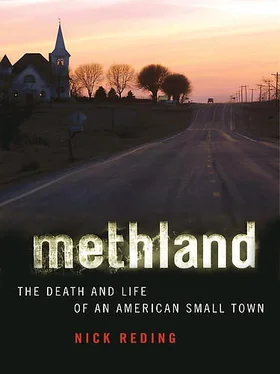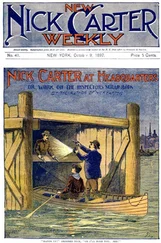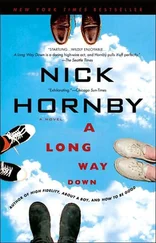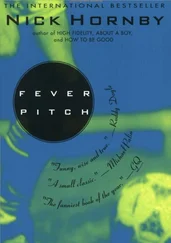Jarvis speaks in a metaphorical language of addiction, honed over decades of repeating the same scenes in his mind like tapes on interminable loops. Tweakers are rats, crank is cheese, cops are cats. At the end of each story, all three end up in the same house, the same motel, or the same barn, where invariably something either very bad or very funny, or both, has just occurred. The venues for these stories are small towns and middling cities, from Oelwein to Sioux Falls, South Dakota. Often the stories are compendiums of rural kitsch that, though they unfold over the course of many years, appear to stretch the year 1987 into several decades. In them, everyone drives a Corvette or a Trans Am and wears Porsche driving glasses. For Jarvis, it’s the memory of the cars, more than that of the days at a time spent having sex with teenage girls, or of the houses he bought and sold, or of the thrill of outwitting the cats, that remains the enduring emblem of how once—a long time ago, and however briefly—he’d finally arrived.
Jarvis’s mother has been listening from the kitchen as he speaks. Seen through a pall of cigarette smoke, backlit by the rays of sun pouring through the kitchen window, with her greasy black hair worn back off her steep, leather-brown face, she looks like a nineteenth-century Apache in a sepia-tone portrait. For the past few hours (if not the past few years), she and a neighbor have been playing gin rummy and drinking cans of Hamm’s beer. Looking at her son now, she calls out, “Tell the man the truth, Roland.”
Summing up his years as a batcher, Jarvis says dutifully, and loud enough that his mother can hear, “It was all a big mess. I lost everything of any value.” His face, however, tells another story. For, as he remembers, it’s the first time in hours that he has smiled.
CHAPTER 3
THE INLAND EMPIRE
As the weeks that I traveled around the Midwest, the Southeast, and California turned to months in the summer and fall of 2005, I was beginning to see meth in America as a function not just of farming and food industry trends in the 1980s and ’90s but also of changes in the narcotics and pharmaceuticals industries in the same period. It would take a few more years of watching what happened in Oelwein, and in the United States at large, before I completely understood what I was seeing. That, for instance, as economies had dwindled throughout the Great Plains and the Midwest, they had aligned a certain way in Southern California, and that the electrical current sweeping between these two increasingly unrelated American places, the coast and the middle, would presage what came to be called the “meth epidemic” thirty years later. So, too, would it take a while to see that the changes that linked Long Beach and Los Angeles with Oelwein were in fact changes tied to the emergence of the global economy. And that meth, if it is a metaphor for anything, is a metaphor for the cataclysmic fault lines formed by globalization.
Back in 2005, these things were just coming into focus as I went to Ottumwa, a town in southeast Iowa. It was in Ottumwa that the Midwest’s principal meth wiring had been installed, and to which the drug’s early advancement into Oelwein could be traced. If Oelwein was shaping up to be the face of meth in modern America, and an indicator of life in modern, rural America in general, then in Ottumwa there was a picture of Oelwein’s skeletal forebears. And eventually a picture of Oelwein’s future, though that part of the story was yet to evolve.
Like Oelwein, Ottumwa had for most of its history been a very prosperous place. Also like Oelwein, Ottumwa was a kind of economic outpost, a wealthy waypoint on the trade routes running between St. Louis, Chicago, and Omaha. Thanks to the Des Moines River, which runs right through the middle of Ottumwa, industry and transportation came quickly to the area once it was settled by a land rush in 1843. In 1850, John Morrell and Co. opened a flag-ship, state-of-the-art meat-processing plant in the center of town. By 1888, there were 10,500 miles of railroad track in Wapello County. Fifty-seven passenger trains on seven lines, the Burlington Railroad being the most famous, crossed the county every day. By the turn of the twentieth century, factories in Ottumwa made everything from boxcar loaders to cigars, and corn huskers to violins. By 1950, Ottumwa was home not only to over fifty thousand people but also to the largest air force base in the Midwest. Almost half the working-age men in town were in the employ of Hormel (the modern incarnation of John Morrell’s packing plant) or John Deere, the farm-equipment manufacturer, where workers could hope, at a minimum, to maintain a lower-middle-class existence.
By 1980, though, Ottumwa’s fortunes had, like Oelwein’s, begun to decline. The story was much the same. The railroad’s demise was followed by the closing of the air force base and then, in 1987, by the sale of Hormel to Excel Meat Solutions, a subsidiary of Cargill. Along with layoffs, wages, as they did a few years later at Oelwein’s Iowa Ham plant, fell by two thirds. Like the shrinking workforce, the population of Ottumwa itself dried up like a prairie pothole in a drought, falling by an astounding 50 percent in just twenty-five years. Soon the town, starved of tax revenue and disposable income, was verging on bankruptcy. And, as had happened in Oelwein, methamphetamine moved into the new economic gap. The difference was that Ottumwa, more than any other place, defined the development of the modern American meth business in the Midwest. Meth from Ottumwa first helped to create, and then to sustain, the market not just in Oelwein but also in towns all over Iowa, Missouri, Nebraska, Kansas, and the Dakotas.
How this happened depended in several trends and events that merged seamlessly into one another: emigration routes from the Midwest to California as working-class men and women headed to the coast in search of employment; immigration routes into the heartland as increasing numbers of Mexicans worked against the human tide in order to take low-wage jobs at meat-packing plants; the rise of industrial meth production; the increased lobbying power of pharmaceutical companies; and finally, government apathy, if not disregard, for the very drug war that at the time had been newly declared by First Lady Nancy Reagan.
At the center of it all, back in Ottumwa, stood a woman named Lori Arnold. It was she who was able to weave together these various political, sociological, and chemical threads into the Midwest’s first and last bona fide crank empire, the official moniker for which was the Stockdall Organization, so named for Lori’s second husband, Floyd Stockdall. Lori’s contribution to what at the time was not yet referred to as a “drug epidemic” was that she essentially wrote meth’s gene tic code in the Midwest. With her, the very concept of industrialized meth in places like Iowa was born, and it flourished in relative anonymity for the next ten years. The irony is that, while Lori worked, the Drug Enforcement Administration fruitlessly lobbied for laws that, had they passed, would have prevented Lori from ever going into business.
Lori Kaye Arnold is Ottumwa, Iowa’s most famous daughter. Ottumwa’s most famous son is Lori’s brother, the comedian Tom Arnold, who is perhaps better known as the ex-husband of Roseanne Barr. Lori is forty-five years old, with shoulder-length light-brown hair and a longish, blunt nose, like a skinning knife. With Tom, she shares a toothy, crocodilian smile and the low center of gravity and powerful legs of a middleweight wrestler. Since 2005, I have corresponded with Lori, who’s in federal prison—coincidentally, at the medium-security women’s work camp in Greenville, Illinois, just a few hundred yards from where I met Sean and James during November 2004.
Читать дальше












